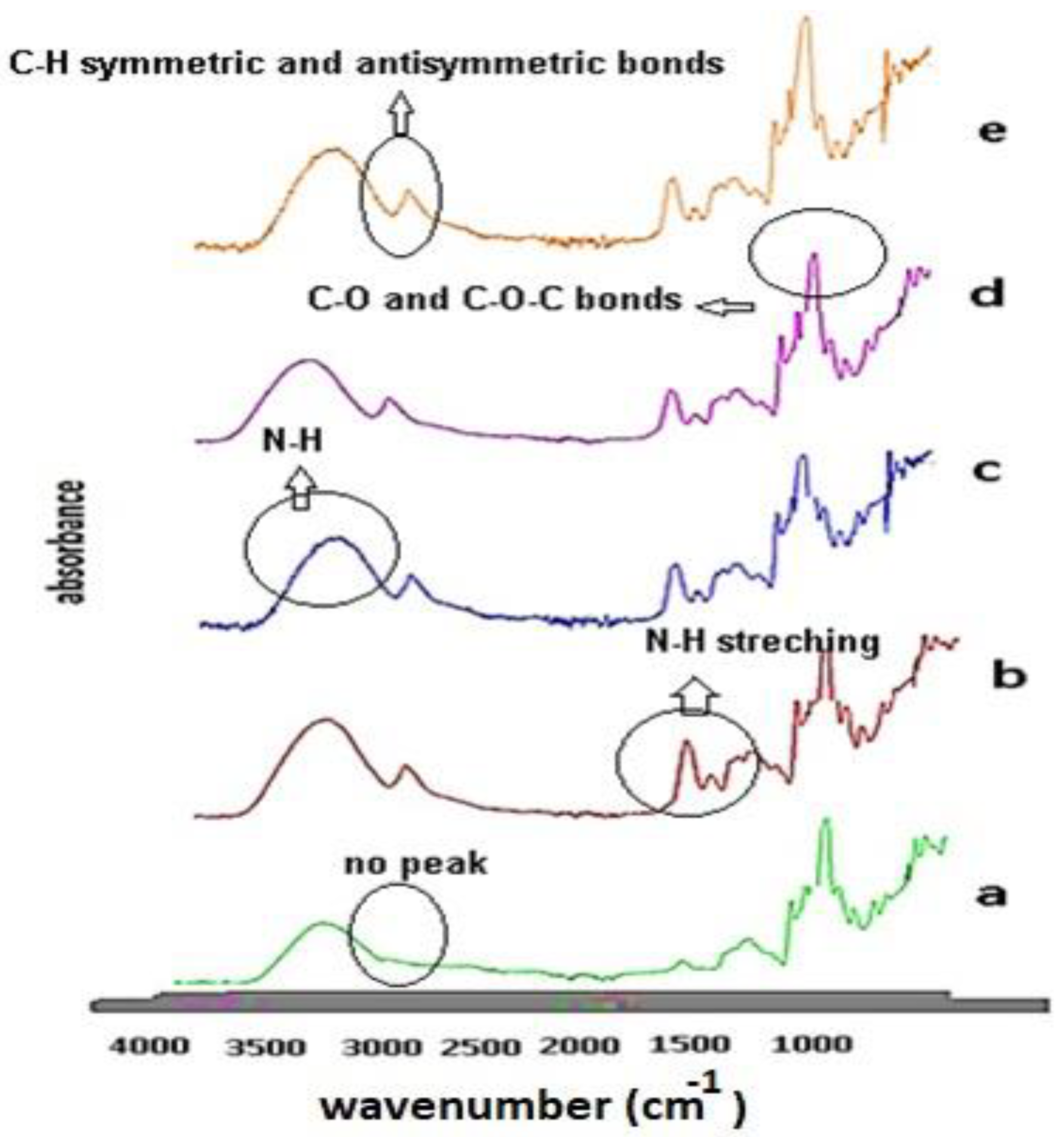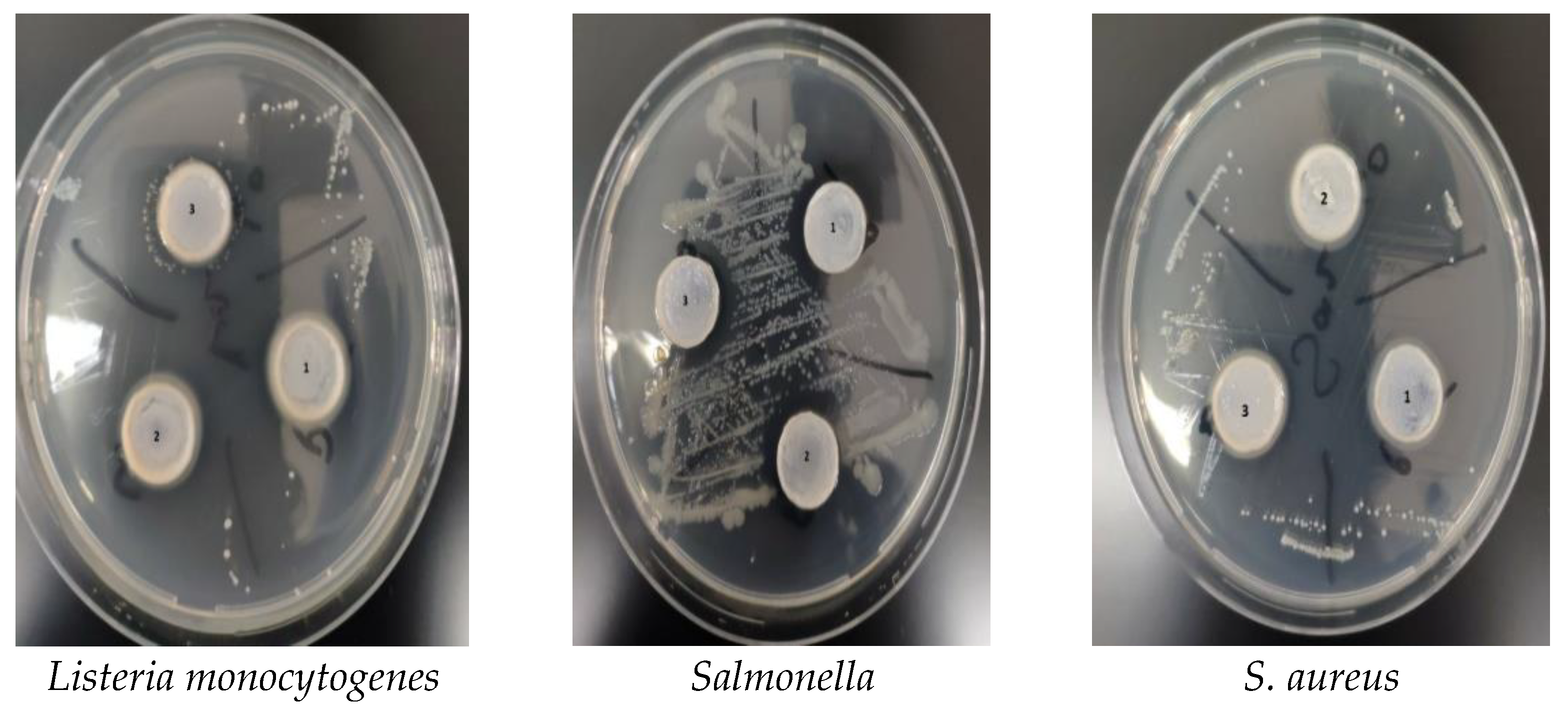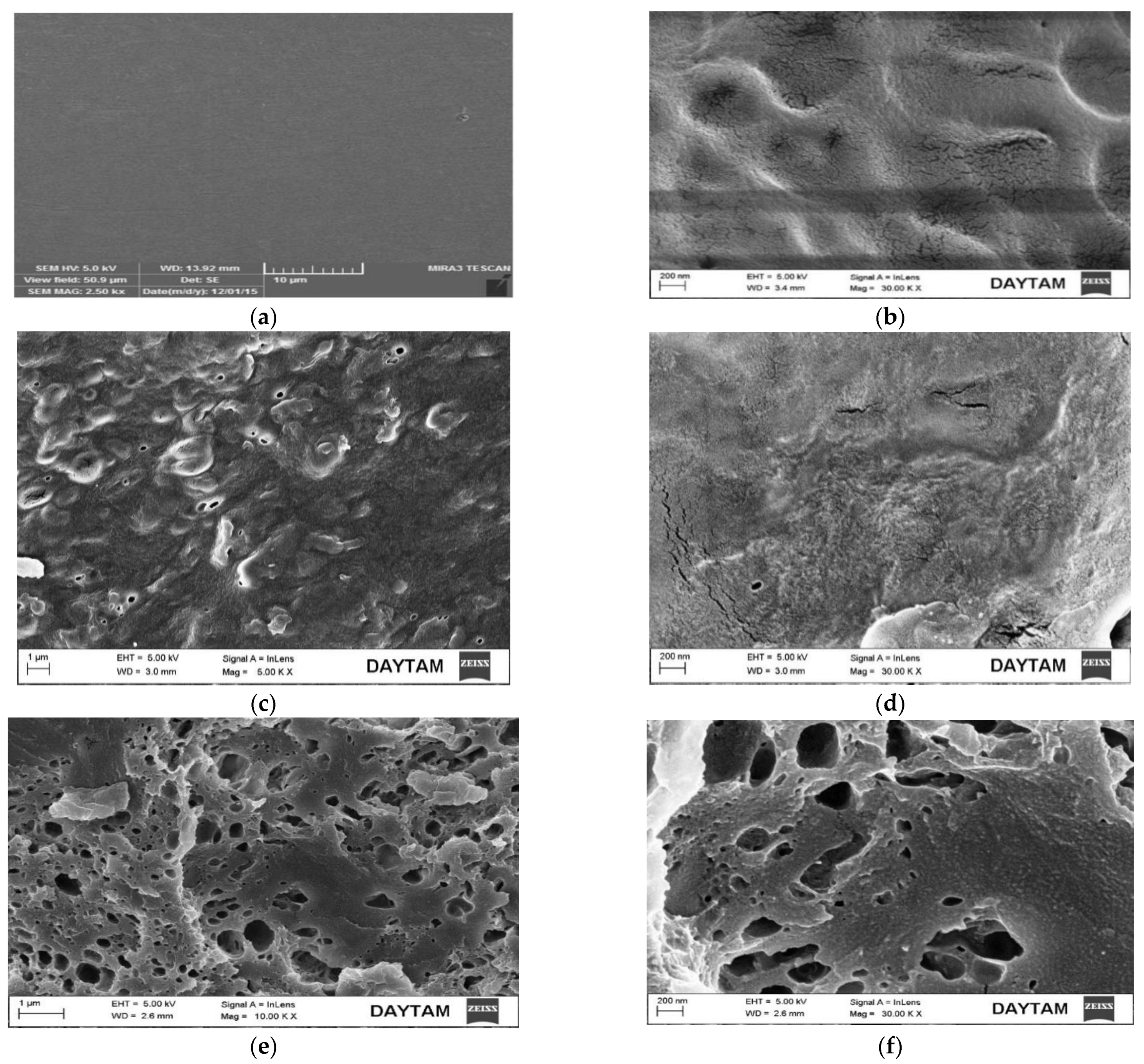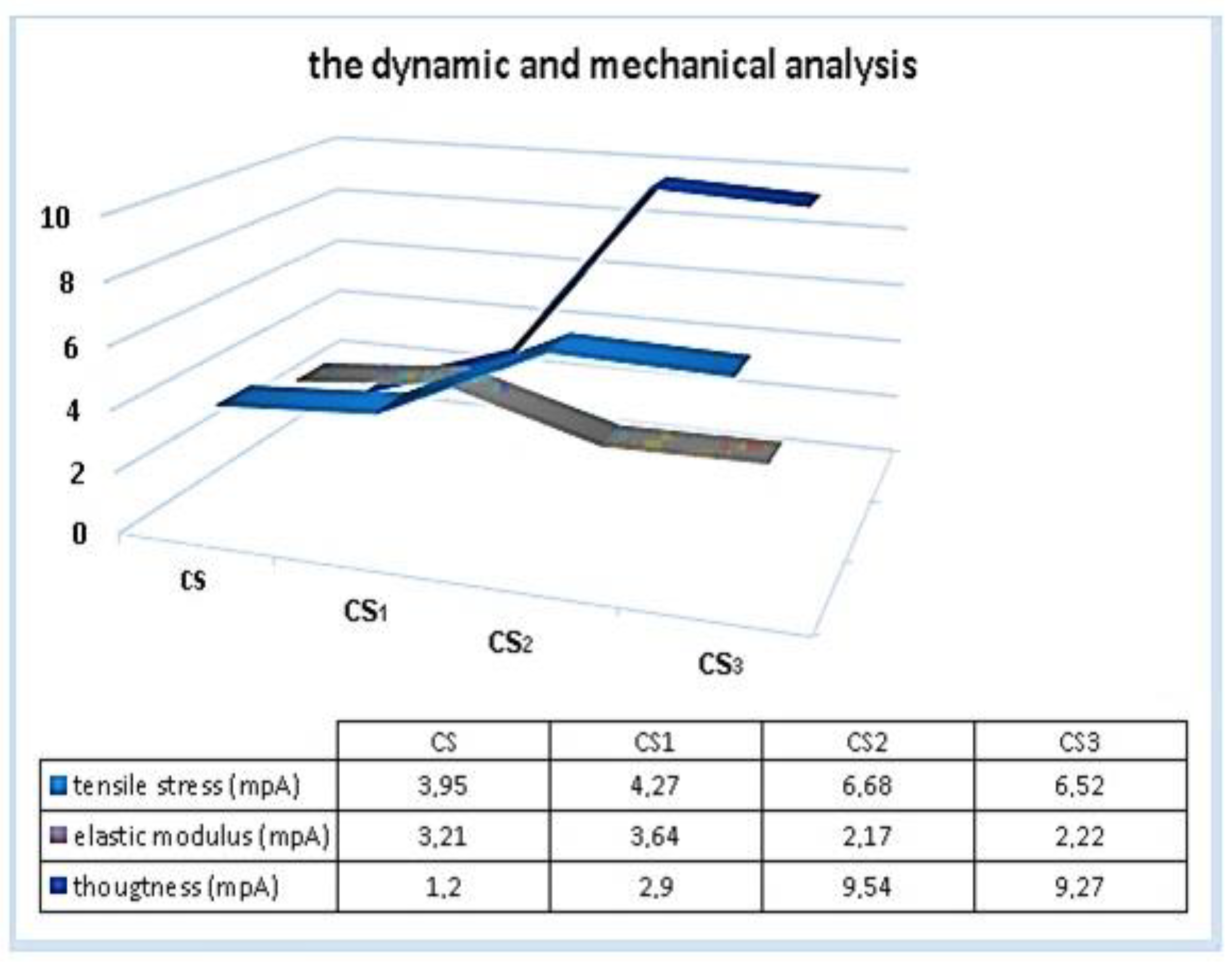Proporties and Synthesis of Biosilver Nanofilms for Antimicrobial Food Packaging
Abstract
:1. Introduction
2. Materials and Methods
2.1. Materials
2.2. Preparation of Samples
2.2.1. Preparation of Goji Berry Extract (Taurine)
2.2.2. The Synthesis of Organoclays
2.2.3. The Synthesis of Silver Nanofilms
2.2.4. Characterization
2.2.5. The Antibacterial Analysis
2.2.6. The Migration Analysis
The Contact Analysis
- 50% ethanol; simulant imitating milk and milk products,
- 10% ethanol; simulant imitating liquid foods,
- 3% acetic acid; simulant imitating acidic foods.
2.2.7. The Statistical analysis
3. Results and Discussion
3.1. HPLC Analysis
3.2. FTIR-ATR Analysis
3.3. The Antibacterial Analysis
3.4. SEM Analysis
3.5. The Migration Analysis
3.6. The Dynamic and Mechanical Analysis
4. Conclusions
Author Contributions
Funding
Institutional Review Board Statement
Data Availability Statement
Acknowledgments
Conflicts of Interest
References
- Öz, M. Health Benefits of Wolfberry, a Functional Nutrient: A Review. Adnan Menderes Univ. Fac. Health Sci. J. 2018, 2, 166–172. [Google Scholar]
- Tarakçı, Z.; Demirkol, D. The Effect of Dried Goji Berry Fruit (Lycium Barbarum) on the Physicochemical Properties of Yogurt. Ordu Univ. J. Sci. Technol. 2016, 6, 136–145. [Google Scholar]
- Chaoran, C.; Shu, F.X.; Jialiang, H.; Guangli, L.; Zhenxing, X.; Hongjie, H. Roles of taurine in cognitive function of physiology, pathologies and Toxication. Life Sci. 2019, 231, 116584. [Google Scholar] [CrossRef]
- Sherif, S.A.; Ihab, K.; Nashaat, N.I.; Hossam El Din, H.; Mohamed, A.E.F. The defensive role of taurine against gonadotoxicity and testicular apoptosis effects induced by cisplatin in rats. J. Infect. Chemother. 2020, 26, 51–57. [Google Scholar] [CrossRef]
- Kaixin, L.; Xiaoxia, S.; Mengxin, L.; Inamullah, P.W.; Mengren, Z.; Cong, Z.; Qiujuan, L.; Yachen, W.; Fengyuan, P. Taurine protects against myelin damage of sciatic nerve in diabetic peripheral neuropathy rats by controlling apoptosis of schwann cells via NGF/Akt/GSK3β pathway. Exp. Cell Res. 2019, 383, 111557. [Google Scholar] [CrossRef]
- Baysal, G.; Doğan, F. İnvestigation and Preparation of Biodegradable Starch-Based Silver nanofilms for Potential use of Curcumin and Garlic in Food Packaging Applications. J. Biomater. Sci. Polym. Ed. 2020, 31, 1–17. [Google Scholar] [CrossRef]
- Khodaeimehr, R.; Peıghambardoust, S.J.; Peıghambardoust, S.H. Preparation and Characterization of Corn Starch/Clay Nanocomposite Films: Effect of Clay Content and Surface Modification. Starch/Staerke 2018, 70, 3–4. [Google Scholar] [CrossRef]
- Baysal, G.; Yılmaz Çelik, B. Synthesis and Characterization of Antibacterial Biosilver nanofilms for Food Packaging. J. Environ. Sci. Health B 2018, 54, 79–88. [Google Scholar] [CrossRef]
- Demircan, B.; Ocak, Ö.Ö. Current and Future Application Potential of Transporting Food Additives using Edible Films and Coatings. Sinop Univ. J. Sci. 2019, 4, 130–150. [Google Scholar]
- Von Goetz, N.; Fabricius, L.; Glaus, R.; Weitbrecht, V.; Günther, D.; Hungerbühler, K. Migration of silver from commercial plastic food containers and implications for consumer exposure assessment. Food Addit. Contam. A Chem. Anal. Control Expo. Risk Assess. 2013, 30, 612–620. [Google Scholar] [CrossRef]
- Li, W.; Zheng, K.; Chen, H.; Feng, S.; Wang, W.; Qin, C. Influence of nano titanium dioxide and clove oil on chitosan-starch film characteristics. Polymers 2019, 11, 1418. [Google Scholar] [CrossRef] [PubMed] [Green Version]
- Peıghambardoust, S.J.; Peighambardoust, S.H.; Mohammadzadeh, P.N.; Pakdel, P. Properties of Active Starch-Based Films İncorporating A Combination of Ag, Zno and Cuo Nanoparticles for Potential Use İn Food Packaging Applications. Food Packag. Shelf Life 2019, 22, 100420. [Google Scholar] [CrossRef]
- Martinez-Pardo, I.; Robert, A.S.; Benu, A.; Raju, A. Thermoplastic starch-nanohybrid films with polyhedral oligomericsilsesquioxane. Carbohydr. Polym. 2017, 173, 170–177. [Google Scholar] [CrossRef]
- Guanjie, Z.; Xiaoyong, S.; Fusheng, C.; Zhixiang, S. Physical and structural characterization of edible bilayer films made with zein and corn-wheat starch. J. Saudi Soc. Agric. Sci. 2018, 18, 324–331. [Google Scholar] [CrossRef]
- Sawabe, Y.; Tagami, T.; Yamasaki, K. Determination of taurine in energy drinks by HPLC using a pre-column derivative. J. Health Sci. 2008, 54, 661–664. [Google Scholar] [CrossRef] [Green Version]
- Abreu, A.S.; Oliveira, M.; De, S.A.; Rodrigues, R.M.; Cerqueira, M.A.; Vicente, A.A.; Machado, A.V. Antimicrobial nanostructured starch based films for packaging. Carbohydr Polym. 2015, 129, 127–134. [Google Scholar] [CrossRef] [Green Version]
- Ren, L.; Yan, X.; Zhou, J.; Tong, J.; Su, X. Influence of chitosan concentration on mechanical and barrier properties of corn starch/chitosan films. Int. J. Biol. Macromol. 2017, 105, 1636–1643. [Google Scholar] [CrossRef] [PubMed]
- O’Brien, A.; Leach, A.; Cooper, I. Polypropylene: Establishment of a rapid extraction test for overall migration limit compliance testing. Packag. Technol. Sci. 2000, 13, 13. [Google Scholar] [CrossRef]
- Ashutosh, S.; Rachid, L.; Sai Kranthi, V.; Chithra, K.; Valérie, O.; Vijaya, R. Effect of High Electric Field on Secondary Structure of Wheat Gluten. Int. J. Food Prop. 2016, 19, 1217–1226. [Google Scholar] [CrossRef]
- Haihua, Z.; Irakoze, P.C.; Qin, L.; Kexue, Z.; Wei, P.; Huiming, Z. Structural Modification of Wheat Gluten by Dry Heat-Enhanced Enzymatic Hydrolysis. Food Technol. Biotechnol. 2012, 50, 53–58. [Google Scholar]
- Sujka, K.; Kockon, P.; Ceglnska, A.; Ewa Reder, M. The Application of FT-IR Spectroscopy for Quality Control of Flours Obtained from Polish Producers. J. Anal. Methods Chem. 2017, 9, 4315678. [Google Scholar] [CrossRef] [PubMed]
- Zhou, M.; Liu, Q.; Wu, S.; Gou, Z.; Wu, X.; Xu, D. Starch/chitosan films reinforced with polydopamine modified MMT: Effects of dopamine concentration. Food Hydrocoll. 2016, 61, 678–684. [Google Scholar] [CrossRef]
- Nawrocka, A.; Cieœla, J. Influence of silver nanoparticles on food components in wheat. Int. Agrophys. 2013, 27, 49–55. [Google Scholar] [CrossRef]
- Nawrocka, A. Conformational changes in wheat gluten after using Ag-nanoparticles. Int. Agrophys. 2014, 28, 311–317. [Google Scholar] [CrossRef]
- Zhang, Y.; Li, S.; Xu, Y.; Shi, X. Engineering of hollow polymeric nanosphere-supported imidazolium-based ionic liquids with enhanced antimicrobial activities. Nano Res. 2022, 15, 5556–5568. [Google Scholar] [CrossRef]
- Dehghani, S.; Peighambardoust, S.H.; Peighambardoust, S.J.; Hosseini, S.V.; Regenstein, J.M. Improved mechanical and antibacterial properties of active LDPE films prepared with combination of Ag, ZnO and CuO nanoparticles. Food Packag. Shelf Life 2019, 22, 100391. [Google Scholar] [CrossRef]
- Saieh, S.E.; Eslam, H.K.; Ghasemi, E.; Bazyar, B.; Rajabi, M. Physical and morphological effects of cellulose nano-fibers and nano-clay on biodegradable WPC made of recycled starch and industrial sawdust. BioResources 2019, 14, 5278–5287. [Google Scholar] [CrossRef]
- Soleimani, J.; Ghanbarzadeh, B.; Dehgannya, J.; Islami, S.B.; Sorouraddin, S.M. Simulation of nanosilver migration from polystyrene nanocomposite into food simulants. Adv. Nano Res. 2018, 6, 243–255. [Google Scholar] [CrossRef]
- Spasojevic, P.; Zrilic, M.; Panic, V.; Stamenkovic, D.; Seslija, S.; Velickovic, S. The Mechanical Properties of a Poly(methyl methacrylate) Denture Base Material Modified with Dimethyl Itaconate and Di-n-butyl Itaconate. Int. J. Polym. Sci. 2015, 2015, 561012. [Google Scholar] [CrossRef] [Green Version]
- Ubeda, S.; Aznar, M.; Rosenmai, A.K.; Vinggaard, A.M.; Nerín, C. Migration studies and toxicity evaluation of cyclic polyesters oligomers from food packaging adhesives. Food Chem. 2019, 311, 125918. [Google Scholar] [CrossRef]
- European Commission (EC). Regulation (EC) No 1935/2004 of the European Parliament and of the Council of 27 October 2004 on materials and Articles Intended to Come into Contact with Food and Repealing Directives 80/590/EEC and 89/109/EEC. Off. J. Eur. Union 2004, L338, 4–17. [Google Scholar]
- Çinibulak, P. Migration in Food Packaging. Master’s Thesis, Namık Kemal University Institute of Science and Technology, Tekirdağ, Turkey, 2010. [Google Scholar]








| Samples (g) | CS1 | CS2 | CS3 |
|---|---|---|---|
| Mta-40 | - | 1.0 | - |
| Mtb-60 | - | - | 1.0 |
| Taurine | 1.0 | 1.0 | 1.0 |
| Allicin | 1.0 | 1.0 | 1.0 |
| Wheat gluten | 2.0 | 2.0 | 2.0 |
| Whey powder | 1.0 | - | - |
| Corn starch | 8.0 | 8.0 | 8.0 |
| Listeria monocytogenes | Salmonella | S. aureus | |
|---|---|---|---|
| CS1 | 72.95 ± 0.27 | 1547.5 ± 3.16 | 382.02 ± 1.23 |
| CS2 | 379.9 ± 1.39 | 386.88 ± 0.79 | 331.18 ± 1.07 |
| CS3 | 35.87 ± 0.13 | 1884.3 ± 3.65 | 144.77 ± 0.46 |
| Simulant | Acetic Acid3% | Ethanol 10% | Ethanol 50% |
|---|---|---|---|
| Chemical consumption (L) | 0.15 | 0.15 | 0.15 |
| Sample area (cm2) | 70 | 70 | 70 |
| Conditions (°C/h) | 40 °C/10 day | 40 °C/10 day | 40 °C/10 day |
| Average value of CS1 (mg/dm2) | 0.300 ± 0.0056 | 0.299 ± 0.0038 | 0.318 ± 0.0073 |
| Average value of CS2 (mg/dm2) | 0.296 ± 0.0042 | 0.300 ± 0.0033 | 0.297 ± 0.0056 |
| Average value of CS3 (mg/dm2) | 0.300 ± 0.0044 | 0.299 ± 0.0041 | 0.294 ± 0.0047 |
| Simulant | Migration Ratio (mg/dm2) | References |
|---|---|---|
| Mt-GC-CS | 3.65 ± 0.46 | [6] |
| Plastic food containers | 7.90 | [18] |
| PET/PE | 5.29 ± 0.67 | [28] |
| PET/Alu/OPA/CPP | 3.42 ± 0.10 | [28] |
| nanosilver into food simulants | 1.65–2.37 | [28] |
| nanosilver into food simulants (A2–A3) | 0.000032–0.000034 | [10,11,12,13,14,15,16,17,18] |
| CS1, CS2, and CS3 | 0.300 ± 0.0033 | (in this study) |
Disclaimer/Publisher’s Note: The statements, opinions and data contained in all publications are solely those of the individual author(s) and contributor(s) and not of MDPI and/or the editor(s). MDPI and/or the editor(s) disclaim responsibility for any injury to people or property resulting from any ideas, methods, instructions or products referred to in the content. |
© 2023 by the authors. Licensee MDPI, Basel, Switzerland. This article is an open access article distributed under the terms and conditions of the Creative Commons Attribution (CC BY) license (https://creativecommons.org/licenses/by/4.0/).
Share and Cite
Baysal, G.; Demirci, C.; Özpinar, H. Proporties and Synthesis of Biosilver Nanofilms for Antimicrobial Food Packaging. Polymers 2023, 15, 689. https://doi.org/10.3390/polym15030689
Baysal G, Demirci C, Özpinar H. Proporties and Synthesis of Biosilver Nanofilms for Antimicrobial Food Packaging. Polymers. 2023; 15(3):689. https://doi.org/10.3390/polym15030689
Chicago/Turabian StyleBaysal, Gülay, Cihat Demirci, and Haydar Özpinar. 2023. "Proporties and Synthesis of Biosilver Nanofilms for Antimicrobial Food Packaging" Polymers 15, no. 3: 689. https://doi.org/10.3390/polym15030689







